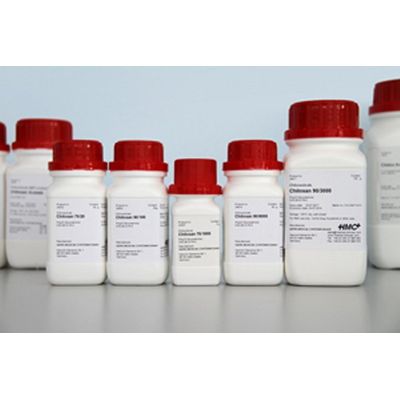

- Home
- Companies
- Heppe Medical Chitosan GmbH
- Products
- HMC - Chitosan Differs

HMC - Chitosan Differs
Due to their different degrees of deacetylation and molecular weights, chitosans are a large group of substances with different properties. In the following, we would like to introduce our product portfolio and show you the broad range of chitosan and its applications.
Chitosan differs from chitin in that it has free amino groups (figure 1) and is obtained by deacetylizing chitin. At a minimum deacetylization level of 70% (=amount of free amino groups in the polymer) it is considered to be chitosan. The monomer of chitosan is D-amino glucose.
- Chemical name: (1,4)-2-Amino-2-desoxy- beta-D-glucan
- Empirical formula: (C6H11NO4)n
- CAS: 9012-76-4
MANUFACTURING PROCESS
During the deacetylization process, chitin undergoes a treatment with lye to divide the acetyl groups from the polymer, resulting in chitosan. This has a variation of properties depending on the degree of deacetylization and chain length.
- Chitoscience® - for scientific research at universities
- Chitoceutical® - for medical technology and pharmceutical industry - this quality line is sudivided into 3 parts - suitable for the current status of your development
- Chitoceuticals® standard - applications in medical technology and first pharmaceutical research
- Chitoceuticals® GMP compliant - medical devices, applications of chitosan as excipient in pharmaceuticals
- Chitoceuticals® GMP - application of chitosan as API, usually derivatization of chitosan is performed - read more about costum manufacturing
HOW TO FIND THE RIGHT CHITOSAN?
Your chitosans are classified in different specifications. This enables you a precise selection and products with constant and reproducible properties. The names of our products consist of quality line, product name, degree of deacetylation and viscosity.
As example: "Chitoceuticals standard Chitosan 95/1500"
- Chitoceuticals standard - quality line
- Chitosan - product
- 95 - degree of acetylation 95%
- 1500 - Viscosity range 1500 mPas
DEGREE OF DEACETYLATION
The degree of deacetylation describes the amount of free amino groups of the molecule. degree of deacetylation % = 100 - degree of acetylation % The higher the degree of deacetylation, the more active is the molecule.
VISCOSITY
As standard, dynamic viscosity is measured as 1% solution in 1% acetic acid. Before measurement, the chitosan is dissolved by stirring for at least 2 hours. The viscosity also gives an indication of the molecular weight, but can not be directly converted.
You can order our Chitoscience® and Chitoceuticals® standard products in our shop. For larger amounts or an offer please contact our sales team.
- Solubility
- soluble in nearly all diluted acids
- insoluble in sulfuric acid and water
- not thermo-elastic, decomposes at 280° C
- pKa 6.3
- high charge carrier density
- biodegradable
- non-toxic
- bacteriostatic
- fungistatic
- film and fiber forming, cross-linking
- immobilization of living organisms
- anti-inflammatory, improves wound healing
- stimulation of immune system and metabolism
- deodorizing
- bonding ability to proteins, heavy metals and aerosols
- wound dressings
- drug delivery
- tissue engineering
- gene delivery
- adjuvant in vaccines
- hydrogels
Read more in our overview of scientific articles.
Chitosan oligosaccharide is an oligomer of β-(1 ➔ 4)-linked d-glucosamine. Chitosan oligomer can be prepared from the deacetylation and hydrolysis of chitin.
APPLICATIONS
- Tissue engineering: chitosan oligomer promotes differentiation of mesenchymal stem cells to osteoblasts – formation of bone tissue
- Drug delivery: vectors for gene delivery – chitosan oligomer forms complexes with plasmid DNA – drug delivery e.g. to lungs and intestinal epithelium
- Wound care: accelerated wound healing process, combination of chitosan and chitosan oligomers for wound dressings
- Antibacterial effects
- Antifungal effects in crops
